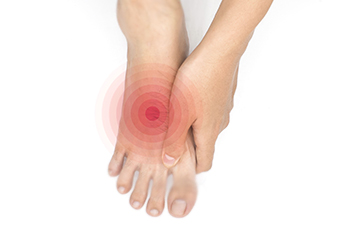Items filtered by date: August 2023
A Guide to Foot Care

Our feet are often overlooked, but they play a critical role in our health and mobility, carrying us around throughout our lives. As we age, foot problems can intensify, potentially affecting our ability to live independently. The foot is a marvel of engineering, with 26 small bones intricately connected by ligaments, muscles, tendons, and cartilage. These components work in harmony to provide support and mobility. Neglecting foot health can lead to backaches, leg cramps, foot problems, and fatigue. To keep your feet in good condition, inspect them daily, moisturize dry skin, wear well-fitting shoes, exercise regularly, maintain proper hygiene, and trim your nails carefully. If foot problems, including athlete’s foot, corns, calluses, or ingrown toenails arise, it is important to get early treatment to avoid complications. Practicing a good foot care routine can help maintain healthy feet and put your best foot forward in life. If you would like to learn more about taking care of your feet, or if you encounter foot issues, it is suggested that you make an appointment with a podiatrist for further information and care.
Everyday foot care is very important to prevent infection and other foot ailments. If you need your feet checked, contact Barbara J. Aung, DPM from Aung Foot Health Clinic . Our doctor can provide the care you need to keep you pain-free and on your feet.
Everyday Foot Care
Often, people take care of their bodies, face and hair more so than they do for their feet. But the feet are a very important aspect of our bodies, and one that we should pay more attention to. Without our feet, we would not be able to perform most daily tasks.
It is best to check your feet regularly to make sure there are no new bruises or cuts that you may not have noticed before. For dry feet, moisturizer can easily be a remedy and can be applied as often as necessary to the affected areas. Wearing shoes that fit well can also help you maintain good foot health, as well as making it easier to walk and do daily activities without the stress or pain of ill-fitting shoes, high heels, or even flip flops. Wearing clean socks with closed shoes is important to ensure that sweat and bacteria do not accumulate within the shoe. Clean socks help to prevent Athlete’s foot, fungi problems, bad odors, and can absorb sweat.
If you have any questions please feel free to contact our office located in Tuscon, AZ . We offer the newest diagnostic and treatment technologies for all your foot and ankle needs.
Dealing With Neuropathic Foot Ulcers

Neuropathic foot ulcers, commonly occurring in individuals with conditions like diabetes or spinal cord injuries, pose significant challenges to foot health. Ulcers form at the site of wounds that won’t heal, causing redness, pain, and inflammation. Treating neuropathic foot ulcers involves several strategies to ensure successful healing and avoid complications. Wound care is essential, involving regular cleansing, dead tissue removal, and proper dressing application to help prevent infections. Specialized shoes or casts can minimize pressure and enhance the healing process. Medications, such as antibiotics and analgesics, can aid in pain control, ward off infection, and accelerate wound healing. Proper management of underlying medical conditions, like diabetes and peripheral neuropathy, also helps to prevent neuropathic ulcers. Lifestyle modifications, including quitting smoking, maintaining a healthy diet, and performing regular exercises, are other ways to reduce risk. A vigilant foot care routine, control of blood sugar levels, and safeguarding the feet against injuries are three important preventative factors. For help with foot ulcers, it is suggested that you make regular appointments with a podiatrist who is trained to deal with this condition.
Neuropathy
Neuropathy can be a potentially serious condition, especially if it is left undiagnosed. If you have any concerns that you may be experiencing nerve loss in your feet, consult with Barbara J. Aung, DPM from Aung Foot Health Clinic . Our doctor will assess your condition and provide you with quality foot and ankle treatment for neuropathy.
What Is Neuropathy?
Neuropathy is a condition that leads to damage to the nerves in the body. Peripheral neuropathy, or neuropathy that affects your peripheral nervous system, usually occurs in the feet. Neuropathy can be triggered by a number of different causes. Such causes include diabetes, infections, cancers, disorders, and toxic substances.
Symptoms of Neuropathy Include:
- Numbness
- Sensation loss
- Prickling and tingling sensations
- Throbbing, freezing, burning pains
- Muscle weakness
Those with diabetes are at serious risk due to being unable to feel an ulcer on their feet. Diabetics usually also suffer from poor blood circulation. This can lead to the wound not healing, infections occurring, and the limb may have to be amputated.
Treatment
To treat neuropathy in the foot, podiatrists will first diagnose the cause of the neuropathy. Figuring out the underlying cause of the neuropathy will allow the podiatrist to prescribe the best treatment, whether it be caused by diabetes, toxic substance exposure, infection, etc. If the nerve has not died, then it’s possible that sensation may be able to return to the foot.
Pain medication may be issued for pain. Electrical nerve stimulation can be used to stimulate nerves. If the neuropathy is caused from pressure on the nerves, then surgery may be necessary.
If you have any questions, please feel free to contact our office located in Tuscon, AZ . We offer the newest diagnostic and treatment technologies for all your foot care needs.
Common Reasons for Big Toe Pain

The foot is a complex structure that contains numerous tendons, ligaments, muscles, and bones, with 19 bones located in the toes themselves. Among the common causes of toe pain are gout, tendonitis, bunions, and osteoarthritis. Rheumatoid arthritis, sesamoiditis, and turf toe are other causes. Gout is a type of arthritis caused by too much uric acid in the system, leading to excruciating big toe pain. Overuse of the big toe, which is instrumental in walking, can lead to inflammation of the big toe joint. Tight-fitting shoes can cause a bump to develop at the base of the big toe, known as a bunion. Pain results from a shift in the biomechanics of the feet and friction caused by shoes. Rheumatoid arthritis can also lead to bunion-like deformities, causing sharp pain. Trauma to the big toe can also trigger osteoarthritis, which is characterized by excessive wear and tear of the toe joints. Sesamoiditis is an inflammation of the tissue surrounding the two tiny sesamoid bones, located at the base of the big toe. Turf toe, an overstretching of the ligament at the base of the big toe. For assistance with big toe pain that is limiting your daily activities, it is suggested that you make an appointment with a podiatrist.
Toe pain can disrupt your daily activities. If you have any concerns, contact Barbara J. Aung, DPM of Aung Foot Health Clinic . Our doctor can provide the care you need to keep you pain-free and on your feet.
What Causes Toe Pain?
Most severe toe pain is caused due to a sports injury, trauma from dropping something heavy on the toe, or bumping into something rigid. Other problems can develop over time for various reasons.
Toe pain can be caused by one or more ailments. The most common include:
- Trauma
- Sports injury
- Wearing shoes that are too tight
- Arthritis
- Gout
- Corns and calluses
- Hammertoe
- Bunions
- Blisters
- Ingrown toenails
- Sprains
- Fractures (broken bones)
- Dislocations
When to See a Podiatrist
- Severe pain
- Persistent pain that lasts more than a week
- Signs of infection
- Continued swelling
- Pain that prevents walking
Diagnosis
In many cases the cause of toe pain is obvious, but in others, a podiatrist may want to use more advanced methods to determine the problem. These can range from simple visual inspections and sensation tests to X-rays and MRI scans. Prior medical history, family medical history, and any recent physical traumatic events will all be taken into consideration for a proper diagnosis.
Treatment
Treatments for toe pain and injuries vary and may include shoe inserts, padding, taping, medicines, injections, and in some cases, surgery. If you believe that you have broken a toe, please see a podiatrist as soon as possible.
If you have any questions please contact our office located in Tuscon, AZ . We offer the newest diagnostic and treatment technologies for all your foot and ankle needs.
Do You Suffer From Painful Feet?
The Importance of Choosing the Right Shoes for Children

As parents, we cherish every moment of our children's growth and development. When it comes to their footwear, making the right choices is crucial. Shoes play a significant role in supporting their feet as they explore the world around them. There are essential tips to look for while buying children’s shoes. Having a proper fit can ensure there is adequate room for growth. Wearing shoes that are soft and flexible can encourage natural foot movement. Having ample arch support can help to aid in proper foot development. Additionally, choosing shoes that are made of breathable materials like mesh or leather can help to keep the feet dry and comfortable. Children's feet grow rapidly, and having regular checkups can help to ensure the right fit. By prioritizing the health and comfort of our children's feet, we empower them to enjoy every step of their journey toward a bright and active future. It is suggested that you speak with a podiatrist who can provide you with additional information about shoes for children.
Making sure that your children maintain good foot health is very important as they grow. If you have any questions, contact Barbara J. Aung, DPM of Aung Foot Health Clinic . Our doctor can provide the care you need to keep you pain-free and on your feet.
Keeping Children's Feet Healthy
Having healthy feet during childhood can help prevent medical problems later in life, namely in the back and legs. As children grow, their feet require different types of care. Here are some things to consider...
Although babies do not walk yet, it is still very important to take care of their feet.
Avoid putting tight shoes or socks on his or her feet.
Allow the baby to stretch and kick his or her feet to feel comfortable.
As a toddler, kids are now on the move and begin to develop differently. At this age, toddlers are getting a feel for walking, so don’t be alarmed if your toddler is unsteady or ‘walks funny’.
As your child gets older, it is important to teach them how to take care of their feet.
Show them proper hygiene to prevent infections such as fungus.
Be watchful for any pain or injury.
Have all injuries checked by a doctor as soon as possible.
Comfortable, protective shoes should always be worn, especially at play.
If you have any questions please feel free to contact our office located in Tuscon, AZ . We offer the newest diagnostic and treatment technologies for all your foot and ankle needs.
How Stress Fractures Occur

Stress fractures often occur in the feet, and can be caused by frequently participating in running and jumping activities. A stress fracture is considered to be a hairline fracture and can be uncomfortable. A patient who has a stress fracture will experience gradual pain, and many people will continue to pursue their chosen activity until walking becomes difficult. At this point, an X-ray or other imaging test can be performed to determine the severity of the stress fracture. Treatment can begin with temporarily stopping the activity and resting the foot as often as possible. Some people choose to wear a protective boot or walking cast, which can provide mobility and stability as the healing process occurs. Stress fractures can also occur from increasing speed and distance too quickly, or from wearing shoes that do not fit correctly. If you have foot pain, and think it may be from a stress fracture, it is suggested that you confer with a podiatrist who can effectively diagnose and treat this condition.
Stress fractures occur when there is a tiny crack within a bone. To learn more, contact Barbara J. Aung, DPM from Aung Foot Health Clinic . Our doctor can provide the care you need to keep you pain free and on your feet.
How Are They Caused?
Stress fractures are the result of repetitive force being placed on the bone. Since the lower leg and feet often carry most of the body’s weight, stress fractures are likely to occur in these areas. If you rush into a new exercise, you are more likely to develop a stress fracture since you are starting too much, too soon. Pain resulting from stress fractures may go unnoticed at first, however it may start to worsen over time.
Risk Factors
- Gender – They are more commonly found in women compared to men.
- Foot Problems – People with unusual arches in their feet are more likely to develop stress fractures.
- Certain Sports – Dancers, gymnasts, tennis players, runners, and basketball players are more likely to develop stress fractures.
- Lack of Nutrients – A lack of vitamin D and calcium may weaken the bones and make you more prone to stress fractures
- Weak Bones – Osteoporosis can weaken the bones therefore resulting in stress fractures
Stress fractures do not always heal properly, so it is important that you seek help from a podiatrist if you suspect you may have one. Ignoring your stress fracture may cause it to worsen, and you may develop chronic pain as well as additional fractures.
If you have any questions please contact our office located in Tuscon, AZ . We offer the newest diagnostic and treatment technologies for all your foot and ankle needs.






